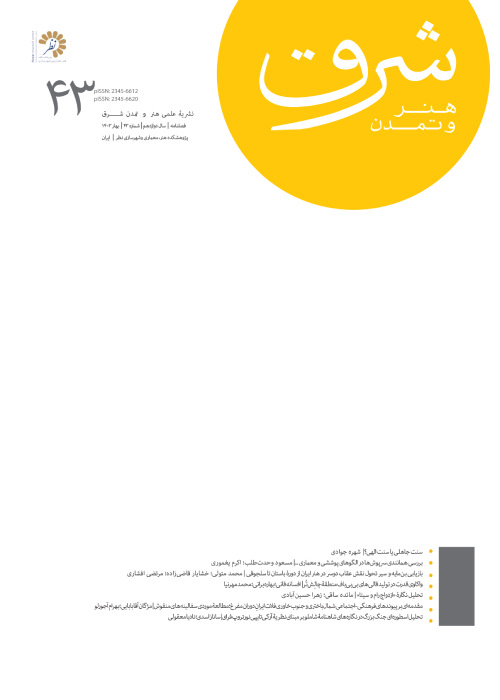The Holy Cattle Slaughterer in the Persian Mithraism
Author(s):
Abstract:
Mitra is one of the oldest myths in Iran. As this belief has directly influenced many traditions and religions, it has aroused the interest of several national and western authors. The effect of Mithraism on Zoroastrian, Christianity, Judaism, and some Islamic and oriental mystics has been investigated. In the antiquity, the mysterious Mithraism directed toward West from Iran, its origin, by militants and warriors. Warmly welcomed, many Mithraeums were built throughout Roman Empire from Turkey and the current Syria to Germany, Poland, Italy, and France. Western Mithraism focuses on the theme of Holy “Cattle Slaughtering” painting and relief in all Mithraism temples; whereas, Mithraism is different in its home land, Iran. During the Sassanid period, the signs of Mithraism began to fade away when Zoroastrian religion was formally recognized. Almost all Mithraism temples were turned into Zoroastrian fire temples where Ahura Mazda, the only god, was accompanied with Mitra and Nahid. However, Mithraism survived and its traditions penetrated into the new religion so much so that Mitra (god of Mehr) accompanied Ahura Mazda. With the arrival of Islam, following Sassanid, fire temples became Islamic holy places and Mithraism customs continued to evolve through transformation in Islamic traditions. Historical misfortunes and religious transformations in the form and the performance of Mithraeums ruined almost all independent Mithraism temples in Iran; while, Mithraeums turned into churches in the west and many Mithraism beliefs spread in the formalized Christianity. However, within the area of the Plateau of Iran, there were some parts such as Armenia underwent the least modifications comparing the central area. Many signs of Iranian Mithraism can be easily seen in Armenian Christianity. Iranian and western Mithraism shares many commonalities; although, there can be seen some fundamental differences1. The effect of Mithraism on Christianity, makes a distinction between western Christianity and Christianity in the Plateau of Iran (Armenia)2. Therefore, the present research attempts to study the differences between Iranian and Western Mithraism based on the Mithraism signs and symbols in various decorations.
Language:
Persian
Published:
Journal of Art and Civilization of the Orient, Volume:6 Issue: 22, 2019
Pages:
19 to 30
magiran.com/p1936579
دانلود و مطالعه متن این مقاله با یکی از روشهای زیر امکان پذیر است:
اشتراک شخصی
با عضویت و پرداخت آنلاین حق اشتراک یکساله به مبلغ 1,390,000ريال میتوانید 70 عنوان مطلب دانلود کنید!
اشتراک سازمانی
به کتابخانه دانشگاه یا محل کار خود پیشنهاد کنید تا اشتراک سازمانی این پایگاه را برای دسترسی نامحدود همه کاربران به متن مطالب تهیه نمایند!
توجه!
- حق عضویت دریافتی صرف حمایت از نشریات عضو و نگهداری، تکمیل و توسعه مگیران میشود.
- پرداخت حق اشتراک و دانلود مقالات اجازه بازنشر آن در سایر رسانههای چاپی و دیجیتال را به کاربر نمیدهد.
In order to view content subscription is required
Personal subscription
Subscribe magiran.com for 70 € euros via PayPal and download 70 articles during a year.
Organization subscription
Please contact us to subscribe your university or library for unlimited access!


